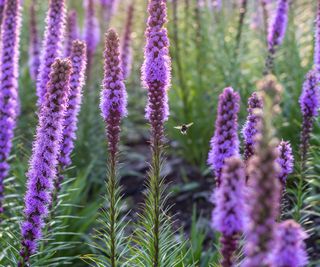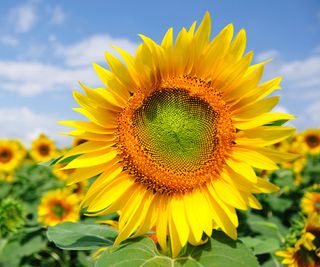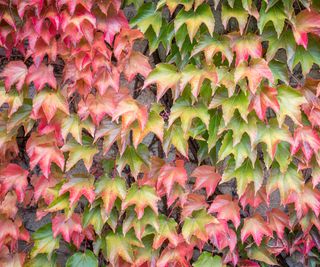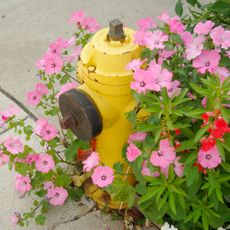9 Bird-Friendly Flowering Plants: Flowers That Attract Birds Through The Seasons
Choose the right flowering plants and your garden will become a favorite hangout for avian visitors. Try these nine flowers that attract birds to your yard


When it comes to choosing flowers that attract birds, the options are virtually limitless. Certain plants serve as a vital resource for birds, helping to foster diverse backyard ecosystems. Creating plants that can foster a veritable bird garden is an endless source of delight – and can also help boost a sense of comfort and safety for your feathered friends.
Though most of these species are ideal for use in the home landscape, many are also suited to container culture or even edible gardens. So which flowers attract birds in the greatest numbers? In this guide, we’ll explore several of the most popular flowering plants that attract birds, as well as how to grow them.
Choosing the Best Flowering Plants for Birds
Flowers that attract birds and butterflies do so for a variety of reasons. Many species of plants are considered to be an invaluable source of nectar and pollen. Other characteristics of a good garden habitat, such as the availability of water and shelter, also play a role in attracting local wildlife. Most flowers that birds love will feature one, if not all, of these traits.
1. Bee Balm

Though bee balm is most known for its ability to attract beneficial insects, it’s really no surprise that it is also among the top flowers for hummingbirds. This is likely due to the plant’s nectar-rich, tubular blooms. As most species of bee balm (Monarda) are considered quite easy to grow, bee balm is a good candidate for establishing carefree beds that are both hardy and resistant to disease.
2. Coneflower

More commonly known as coneflower, Echinacea is prized for its vibrant color and prolific production of flowers. These plants are easily grown from seed, but may not begin blooming in their first season. If you’re after flowers that attract birds and also provide food, you’re in luck. Once coneflowers are established, native bird species will be rewarded with the dependable production of seed lasting from early summer until the arrival of the first frost in fall.
3. Liatris

Liatris is a good choice for containers, pollinator gardens and naturalized spaces. Its lasting flowers linger through summer, allowing ample time to attract hummingbirds and a wide array of beneficial insects. Liatris plants that have been allowed to set seed further attract various species of songbirds, such as goldfinches and titmice. A mature liatris plant can multiply and spread where conditions are ideal, behaving as a perennial in USDA zones 3-9.
4. Mulberry

In addition to seed, plants that produce fruit are especially attractive to birds. Though our feathered friends can sometimes become a nuisance in orchards and other edible spaces, species like mulberry can deter damage and improve the health of the local ecosystem. However, if you plan to grow your own mulberries, use caution, as many species are known for their aggressive nature and invasive habit. Experts suggest growing only native species, with red mulberries among the best options.
Gardening tips, videos, info and more delivered right to your inbox!
Sign up for the Gardening Know How newsletter today and receive a free download of our most popular eBook "How to Grow Delicious Tomatoes."
5. Sunflower

A quintessential member of the summer garden, sunflowers are loved for their cheerful blooms and unique ability to feed native wildlife. They are also amongst the best plants that attract birds to your yard. Growers hoping to attract birds should consider sunflower varieties known for their seed production, such as those with a high oil content. Birds will feed most heavily from midsummer through early fall.
6. Viburnum

Often used in mixed borders or privacy hedges, viburnum meets the needs of most garden birds. Faded viburnum flowers give way to an abundance of brightly colored berries, which stand on plants throughout fall and winter. Their large shrubs further assist birds in need, serving as shelter throughout periods of especially inclement weather in winter.
7. Virginia Creeper

Native throughout much of the eastern United States, Virginia creeper vines can frequently be spotted growing near roadways and at the edges of forests and green spaces. As well as growing flowers that attract birds, their dense foliage provides protection for a variety of small species. Though this vine’s flowers are not considered ornamental, each one gives way to large numbers of fruit from which birds can feed through winter. Just be sure to monitor Virginia creeper’s growth, making certain the plant is not allowed to scale mature trees or nearby structures.
8. Winterberry

As its name would imply, winterberry can impart lasting year-round beauty in the landscape. Bright red berries are held atop the shrub’s branches throughout the entire winter, making it a vital source of food for non-migrating bird species. This includes bluebirds, cardinals, robins and various types of woodpeckers. Winterberry bushes are best planted in spring or early autumn, with full-sun locations resulting in the best production of flowers.
9. Zinnia

Though zinnias have long been celebrated for their use in hummingbird gardens, they are also frequented by a wide range of other bird species. For the best results, allow each zinnia bloom to set seed, rather than deadheading those that have started to fade. Birds are most likely to be seen feeding in zinnia beds from late summer through fall.
Frequently Asked Questions
What Flower Attracts Birds the Most?
Birds are attracted to flowers that meet their needs. Adding a wide range of plant species to growing spaces will help to diversify the garden, and increase the numbers of feathered visitors to the space. Gardeners able to consistently account for birds’ needs through spring, summer, fall and winter are most likely to have a consistent influx of birds.
What Kinds of Flowers Attract Birds and Butterflies?
Many plants that attract birds to yard spaces draw them due to their immense seed production. However, nectar and pollen also play a role. This is especially true for growers hoping to lure a combination of bees, birds, butterflies and other beneficials.

Tonya Barnett has been gardening for 13 years. Flowers are her passion. She has trasformed her backyard into a cut flower garden, which she regularly chronicles on her YouTube channel http://www.youtube.com/@tonyawiththeflowers.
-
 7 Best Trailing Plants For Hanging Baskets – Create A Delightful Summer Display
7 Best Trailing Plants For Hanging Baskets – Create A Delightful Summer DisplayHanging baskets are a staple of the summer patio. Use these plants to create trailing masterpieces that add beauty and elegance to your outdoor space.
By Melanie Griffiths
-
 Old-Fashioned Flowers And Plants That Will Transport You To Another Time
Old-Fashioned Flowers And Plants That Will Transport You To Another TimeFancy bringing some old world beauty and elegance to your space? These nine old-fashioned flowers can help you add a touch of nostalgia and romance
By Mary Ellen Ellis
-
 Support California Dogface Butterfly: Do More For Zerene Eurydice
Support California Dogface Butterfly: Do More For Zerene EurydiceWould you like to know how to support California’s state insect? We explain the vital pollinating role of the California dogface butterfly and how to help it in your backyard
By Teo Spengler
-
 Try These Hummingbird Vines: 8 Best Flowering Vines For Hummingbirds
Try These Hummingbird Vines: 8 Best Flowering Vines For HummingbirdsWant to improve your chances of attracting some of the world’s most charming avian visitors? Here are the best eight flowering vines for hummingbirds
By Tonya Barnett
-
 Beautiful Butterfly Garden Ideas: 10 Ways To Attract Pretty Pollinators To Your Yard
Beautiful Butterfly Garden Ideas: 10 Ways To Attract Pretty Pollinators To Your YardBringing butterflies to your backyard is one of the most important ways you can enhance wildlife, boost pollination and improve biodiversity. These 10 butterfly garden ideas can get you started
By Mary Ellen Ellis
-
 Landscaping Around A Fire Hydrant: Landscaping Tips And Safety Considerations
Landscaping Around A Fire Hydrant: Landscaping Tips And Safety ConsiderationsIt might not sound like the obvious choice for a landscaping project, but a fire hydrant can work with a bigger gardening vision. Follow our tips on landscaping around a fire hydrant
By Mary Ellen Ellis
-
 Planting For Chickens: Why You Should Plant A Chicken Garden
Planting For Chickens: Why You Should Plant A Chicken GardenIf you’ve never considered planting for chickens, this is your chance to enjoy their joyful benefits. We show you how to make an easy chicken garden
By Amy Grant
-
 Why It's Time To Raise Ducks For The Garden – Move Over, Chickens!
Why It's Time To Raise Ducks For The Garden – Move Over, Chickens!Others might call you quackers, but if you get some ducks for the garden, you can enjoy a host of plot-friendly benefits. Just follow our expert guide to make the most of these unique creatures
By Mary Ellen Ellis
-
 Dark Home Exterior? Choose The Right Plants With Our Expert Dark House Landscaping Tips
Dark Home Exterior? Choose The Right Plants With Our Expert Dark House Landscaping TipsIf the front or back of your house is very dark, what are the implications for the plants you grow? We reveal how understanding dark house landscaping can help you pick the right plants
By Susan Albert
-
 Best Plants For Frogs: 7 Plant Varieties To Bring More Froggies To Your Yard
Best Plants For Frogs: 7 Plant Varieties To Bring More Froggies To Your YardA frog-friendly environment is one of the key indicators for garden health – so if you want to improve the health of your plot, here are seven plants for frogs you need to try
By Janey Goulding